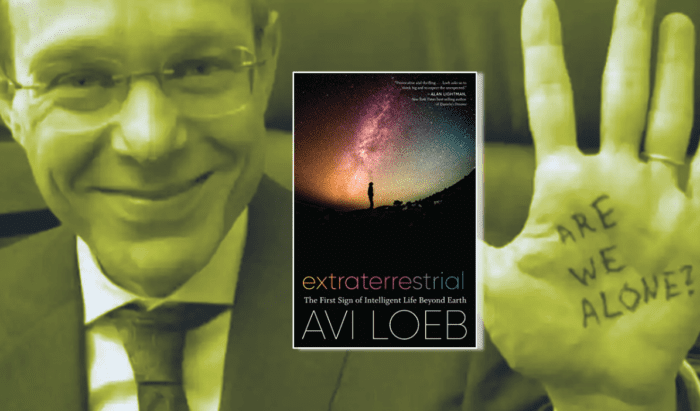
Our interview with Avi Loeb, author of “Extraterrestrial: The First Sign of Intelligent Life Beyond Earth.”
When a mysterious object was detected passing through the solar system in 2017, Harvard University astronomer Avi Loeb found himself fascinated by it. He hypothesizes that it is the first interstellar object ever detected by humanity—a theory he details in his new, bestselling book Extraterrestrial: The First Sign of Intelligent Life Beyond Earth.
Loeb, the Frank B. Baird Jr. Professor of Science at Harvard, told DigBoston in an interview that the book has “two important messages.”
“One, here is the first object we found in interstellar space that could be artificial in origin,” Loeb said.
The second message applies to what he calls the pushback he has received from the scientific community:
“The community as a culture is not receptive to innovation,” he said, adding that his theory about ‘Oumuamua has received a less welcoming reception than proponents of other ambitious ideas such as the multiverse or an extra dimension.
Loeb does have multiple positions of responsibility in the scientific world, and has collaborated on numerous achievements. He directs the Black Hole Initiative, which captured groundbreaking images of this scientific phenomenon; he is part of the President’s Council of Advisors on Science and Technology; and he set a record for tenure as the Harvard astronomy department chair. Born in Israel, his first academic position in the US was a fellowship at the Institute for Advanced Study at Princeton before receiving tenure at Harvard.
“I don’t take for granted all of the steps that brought me to where I am,” Loeb reflected. “I had sufficient independence as department chair for nine years.” He added, “I was quite dependent on other people every step along the way. It could have turned [out] very different. Many people were not as fortunate, they were not given the opportunities.”
Loeb is open to exchanging views with other academic disciplines, which sometimes yields surprising insights. He recalls attending a student’s Ph.D exam in the English department, when her professor brought up the death of Renaissance thinker Giordano Bruno, who was burned at the stake in 1600.
“The actual reason” for Bruno’s death, he recalls the professor saying, was that Bruno believed there were “other stars” that might have “planets like the Earth around them, you could have life on the planets. It was an offense to the church.”
And yet, Loeb said, it was “quite reasonable.”
Loeb began making his own hypothesis for extraterrestrial life after examining images of the unusual object detected by the Pan-STARRS telescope in Hawaii. The object was nicknamed ‘Oumuamua, a Hawaiian word roughly akin to “scout.”
“As time went on, it looked more and more peculiar,” Loeb said, “something I never had seen before.”
Images showed its shape as potentially elongated and flat, and it spun every eight hours. These were among the reasons that led Loeb to rule out a natural origin for the object.
He does not believe it was a comet because he did not see a comet tail, and he dismissed the possibility that it was a collection of dust particles, citing its spin, which he said would make it hard for such a collection to survive over millions of years in interstellar space. He also finds it hard to believe that an object with ‘Oumuamua’s shape could have successfully broken off from a much bigger object close to a star.
What is possible, according to Loeb, is that ‘Oumuamua was like “a plastic bottle on a beach.”
“A beach has natural objects,” he explains, “rocks, seashells. Every now and then, there’s something like a plastic bottle, where you learn that a civilization produced it. The possibility is quite real” due to “all the anomalies” of ‘Oumuamua.
He describes himself as “very interested in the question, ‘are we alone,’ are there other technological civilizations, and so forth.”
It’s an issue Loeb said should be more widely discussed. The public is certainly listening: His book was No. 7 on the New York Times bestseller list for the first week of February, as well as an editor’s pick. Yet, he lamented, the scientific community has yet to come around.
“Some say extraordinary claims require extraordinary evidence,” Loeb said. “It’s in the eyes of the beholder.”
For Loeb, there are multiple possibilities for intelligent life beyond our solar system. He notes that half of all stars comparable to the Sun have a planet “the size of Earth with the same sort of separation from the star,” with possibilities for “liquid water, plants, a chance of life.”
Loeb devotes part of the book to musing on what life elsewhere in the universe might look like. When he spoke with DigBoston, he likened it to cosmic dating.
“You go on a date, you have a good reason to expect the other person to be human, just like you, to look similar, to have the same genetic makeup,” Loeb said. “Life on another planet,” he noted, “could look really strange, very different biologically.”
He’s also interested in potential commonalities, including as stated in the theory of panspermia, that life on Earth was created out of dust coming from elsewhere in the universe.
“We know that rocks have been exchanged between the Earth and Mars, the Earth and Venus,” Loeb said, adding that life could have survived in a rock from Mars at a certain temperature threshold.
And, he asked, “how long can a microbe survive inside a rock? We estimate it could be 100,000 years, maybe up to one million years, allowing some range of distance to be traveled throughout the galaxy. It could make life much more complicated if it happened.”
Not only does Loeb consider what happened back in time, he also envisions what may happen if humans encounter extraterrestrial technology in the future.
“It would offer an opportunity for us to use them and deploy them on Earth,” he said. “I think it would be a learning experience.”
As he noted, “We have been developing technology over hundreds of years on an exponential growth every few years. A hundred years, a thousand years, a million years from now, all the technologies we’re able to use will be completely unimaginable to us today.”
And yet he wonders whether there are some fundamental purposes across technology and time.
In the story of Noah’s Ark, Loeb said, “its size in the Bible is roughly the size of ‘Oumuamua. It’s just a coincidence.”
Or is it?
“In the story, [Noah] preserved all the animals [so] they survived the great flood,” said Loeb, who envisions a similar catastrophe befalling the Earth in the future, similar to the asteroid that killed off the dinosaurs. He suggests a preparation for such a cataclysmic event—Noah’s spaceship instead of an ark. “At first load the whales, elephants, all kinds of animals, birds, sea creatures,” he said. “It could be quite small, just needing a computer system with AI and a 3D printer with DNA information … [Send it] off to the planets.”
Rich Tenorio is a writer and editor whose work has appeared in international, national, regional and local media outlets. He is a graduate of Harvard College and the Columbia University Graduate School of Journalism. He is also a cartoonist.

